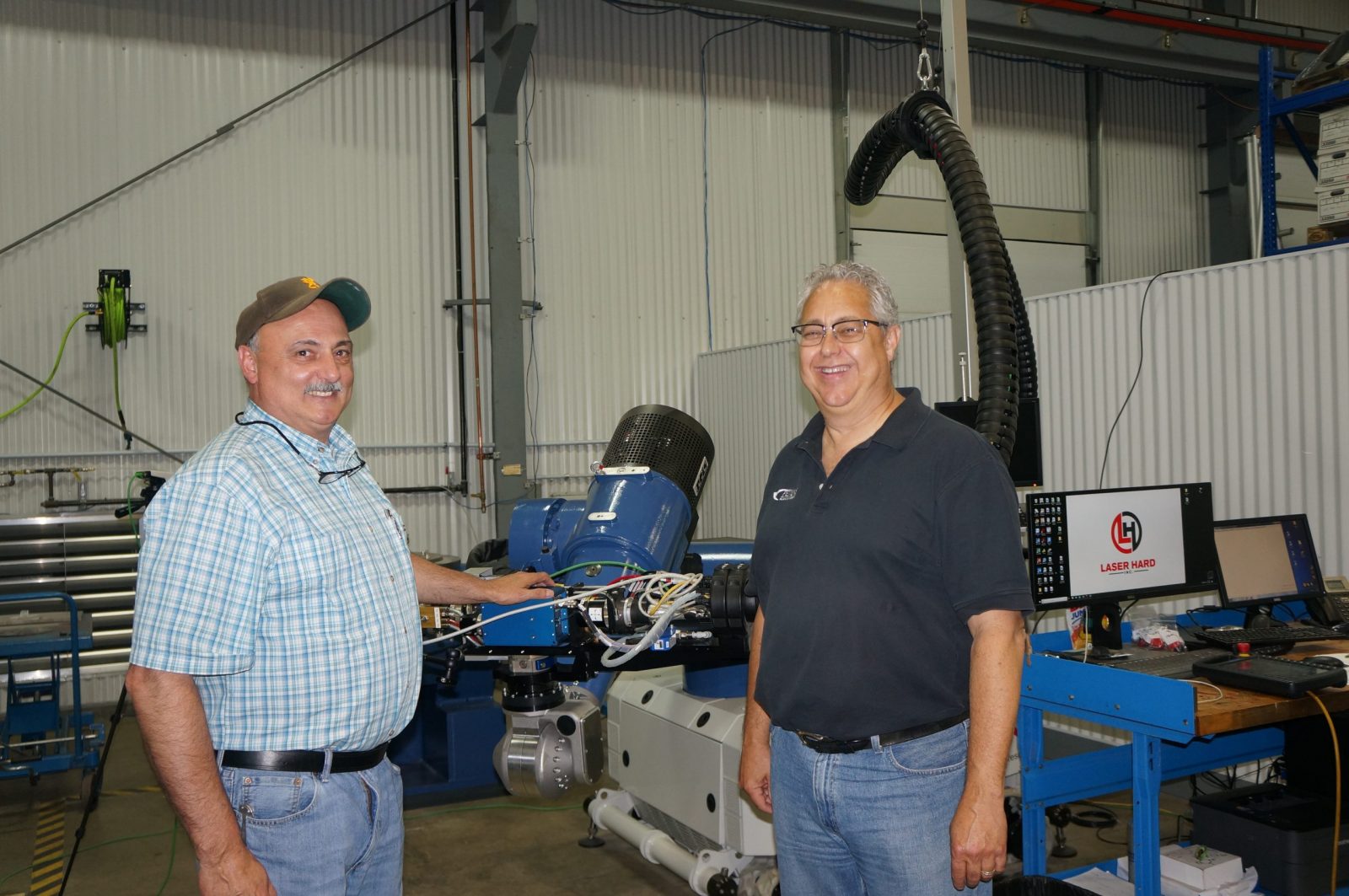Laser Heat Treating Dies for Electric Vehicles
From Aravind Jonnalagadda, CTO, Co-Founder at Synergy Additive Manufacturing, LLC., we have this interesting article about laser heat treating of dies. Over the years “The Monty Heat Treat News” has run across laser heat treating just a handful of times, one of the few concrete examples we can think of is “Laser Hard” in Pennsylvania, USA a joint venture founded in 2018 by Doug Peters of Peters Heat Treating and partners (these two photos show the facility as we saw it at the grand opening, Doug is on the right). According to this article laser heat treating of dies makes a great deal of sense. However having said that two points in this article puzzle us.
In this article the author mentions that dies are typically heat treated by “Conventional heat treating processes such as induction and flame”, rather odd that the most common method of heat treating dies, vacuum is not mentioned. The second point is that the author has zeroed in on Electric Vehicles-we would assume that heat treating of dies for internal combustion vehicles would be exactly the same. However aside from these two minor points we found the article interesting-whether this method of heat treating will take off is something only time can tell us.
The Electric Vehicle (EV) initiative and the efforts of automakers to overhaul their current vehicle lineups with electric offerings has many automakers and technology corporations rethinking automotive engineering to the most minute detail of manufacturing. The modern automotive industry not only effects automakers, but consumers, who will also transition into a diverse new market of emerging technologies. Deloitte Insight estimates that by 2030, EVs will account for 31 percent of total market share for new car sales. Currently EVs account for 2.5 % total new car sales. As per the report, the worldwide market for new EVs is expected to swell from 2.5 million in 2020, to 11.2 million in 2025, to 31.1 million by 2030. [1]
With a surge in demand for new EVs, OEMs are racing to bring new models to the market. This demand has prompted automakers to push towards shorter product life cycles for EVs compared to their Internal Combustion Engine (ICE) counterparts. Along with this, the recent supply chain disruptions fueled a renewed push towards new technologies and reliable partners who can accelerate the product life cycles while reducing the overall manufacturing costs. One such technology that gained strong hold in tool and die industry over the last few years is Laser Heat Treating.
Automotive dies often require all the male radii to be heat treated to reduce the wear and improve die life. Conventional heat treating processes such as induction and flame have high heat input, which distorts the die. To account for this, the die makers leave extra stock material to later comeback and hard mill the die to final dimensions. This additional hard milling step adds substantial cost to the die manufacturing process. Conventional processes are often performed by hand and lack precision and control. This results in poor quality and inconsistencies in the heat treated surfaces. Laser heat treating on the other hand, results in minimal distortion. The dies are machined to their final form and laser heat treated as a final step, thereby reducing the process steps such as hard-milling, 2D based machining, etc. This saves substantial time and costs for the die makers, not to mention improved and repeatable quality.
Laser heat treating process involves in a laser beam (with a typical laser spot size from 0.5” x 0.5” to 2” x 2”) to focus onto the metal surface. With proper control, the incident laser energy raises the surface temperature of the metal above its martensitic transformation temperature. The metal’s thermal mass aids in rapid ‘self-quenching’ (by removing the heat via conduction), resulting in the formation of the desired martensite microstructure. This gives the material its required hardness and wear properties.
By utilizing a laser beam, unrivaled precision is achieved by delivering the smallest possible energy to the metal part, resulting in minimal to zero distortion in large automotive dies. The unique characteristics of laser technology offer the following benefits:
- Minimal to zero distortion
- No hard milling required on large automotive dies
- Consistent hardness depth (via. feedback control)
Autodie LLC, when analyzing at over 100 applicable draw die castings (Post, Cavity and Binders) concluded that an average of 7 day reduction in Time to Market (TTM) was achieved by switching over to Laser Heat Treating process. By avoiding hard-milling operation, Laser Heat Treating resulted in 37% reduction in machining time. Substantial savings in cutter cost was observed as the castings are now finished by 3D machining while in soft condition. Over a 11 months period Kaizen savings had a benefit to cost average of 28.6 [2]
In summary, Laser Heat Treating offers substantial costs savings as well as reduction in Time To Market. This process is likely to expand in the automotive and metal part manufacturing sector. Laser Heat Treatment faces no significant barriers to adoption, aside from the ones that are common to any emerging technology. These include lack of familiarity and a shortage of reliable suppliers. The savings, measured by cost, schedule, quality, and energy reduction, are significant and well supported.
About Synergy Additive Manufacturing LLC:
Synergy Additive Manufacturing LLC is ISO 9001:2015 certified company specializing in high power laser-based solutions for complex manufacturing challenges related to wear, corrosion and tool life. Synergy Additive Manufacturing provides custom laser systems and job shop services for laser heat treating, metal based additive manufacturing, and laser welding.
Did you like this article? Click here to subscribe to The Monty.
View our recent magazines and podcasts by clicking the following link. https://themonty.com/magazine/


